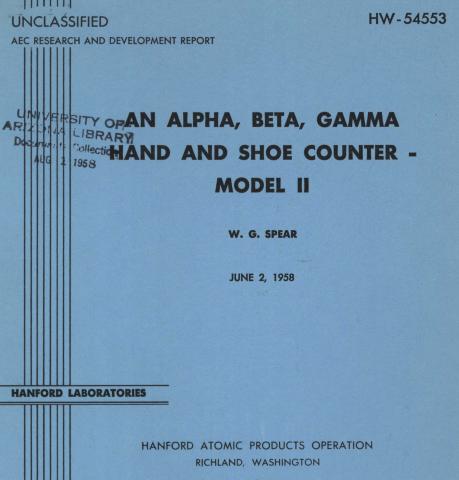The Hanford Reservation in south central Washington is one of several historic weapons-production sites in the United States that were identified and created within months in the early 1940s when it became clear to the U.S. government that efforts to create a new, more powerful weapon would influence the outcome of World War II. In addition to Hanford, Oak Ridge, Tennessee, and Los Alamos, New Mexico, were the top secret locations where nuclear weapons were produced.
After the war, the Atomic Energy Commission (AEC) was created to direct peacetime development of atomic science. Large numbers of technical reports began flowing out of national laboratories researching nuclear science, commercial uses of nuclear power, and radioactive materials and their effects on people and the environment.
TRAIL (The Technical Report Archive & Image Library) has been digitizing AEC reports as part of its mission to make accessible historic federal technical reports. To date nearly 5,000 titles, mostly from the 1940s and 1950s, from many laboratories and research sites across the country, such as Argonne National Laboratory, Los Alamos Scientific Laboratory, Lawrence Livermore National Laboratory, Oak Ridge National Laboratory, and Sandia National Laboratory, have been digitized and added to TRAIL.These reports are invaluable for research in topics including atomic energy, the effects of radiation on biological systems, restoration of the environment, radiation cleanup, and the history of the development of the atomic bomb and atomic energy resources in the United States.
Hanford
The United States government took possession of this area in January 1943. 1500 residents of the former towns of White Bluffs and Hanford were evacuated on 30-day notice in early 1943. A massive temporary camp was built that accommodated 51,000 workers over the next 2 years. The Hanford site was in use until 1987 for plutonium production, initially for weapons and later for energy generation. These 40+ years of nuclear reactor use produced solid and liquid wastes that are now in the cleanup phase.
In 1989 a Tri-Party Agreement brought together DOE, U.S. EPA, and Washington State Department of Ecology to bring the reservation into compliance with federal and state environmental regulations. In the intervening years, six reactors have been cocooned, hundreds of support buildings demolished, and new treatment and processing facilities built.
Over 560 technical reports produced at Hanford are available in the TRAIL library, identified by an ‘HW’ prefix. These include:
- The Uptake and Translocation of Cesium by Plants. 1953. HW-35174
- Effect of Process Variables on Graphite Purity. 1954. HW-32497
- The Purex Process: a Solvent Extraction Reprocessing Method for Irradiated Uranium. 1957. HW-49483 A
- An Alpha, Beta, Gamma Hand and Shoe Counter – Model 2. 1957. HW-54553
- Hanford Graphite Superheat Reactor (HGSR) Design Study and Evaluation. 1964. HW-73130
Hanford Site Tours
The Department of Energy offers several tour options of the Hanford Site, a 586-square-mile reservation in south central Washington State. In May 2015, TRAIL Steering Committee member Marilyn Von Seggern (Washington State University) took part in a Hanford Public Tour, a five-hour bus trip that loops through the reservation, stopping at the Cold Test Facility, the B Reactor (now a National Historic Landmark), the Environmental Restoration Disposal Facility, the Plutonium Finishing Plant, the Groundwater Treatment System, and the Waste Treatment Plant. The first half of the tour follows the course of the Columbia River, which played a crucial role in the process by supplying fresh water to cool the graphite in the nuclear reactors.
For many visitors the stop at the B Reactor, on the north edge of the reservation, is the highlight of the tour. It was the world’s first full scale plutonium production reactor when it was built in 1943-44. The 2,004 aluminum process tubes that contained the uranium fuel slugs are visible in the reactor core, and the control room and offices, with period furnishings, can be visited.
Clean-up of the site has achieved some remarkable accomplishments. Twelve billion gallons of groundwater have been treated and more than 12,000 out of 15,000 cubic meters of plutonium-contaminated waste have been retrieved and shipped offsite. But the project will not be completed until 2060, and is budgeted at approximately $2 billion per year.
A 300-square-mile area surrounding the Hanford Site is now the Hanford Reach National Monument under the care of the U.S. Fish & Wildlife Service. On Dec. 19, 2014, President Obama signed the National Defense Authorization Act. This establishes the Manhattan Project National Historical Park, which will recognize the historic nuclear development activities at the three main facility locations: Hanford, Oak Ridge, and Los Alamos.
Thanks to Marilyn Von Seggern for contributing to this article.


